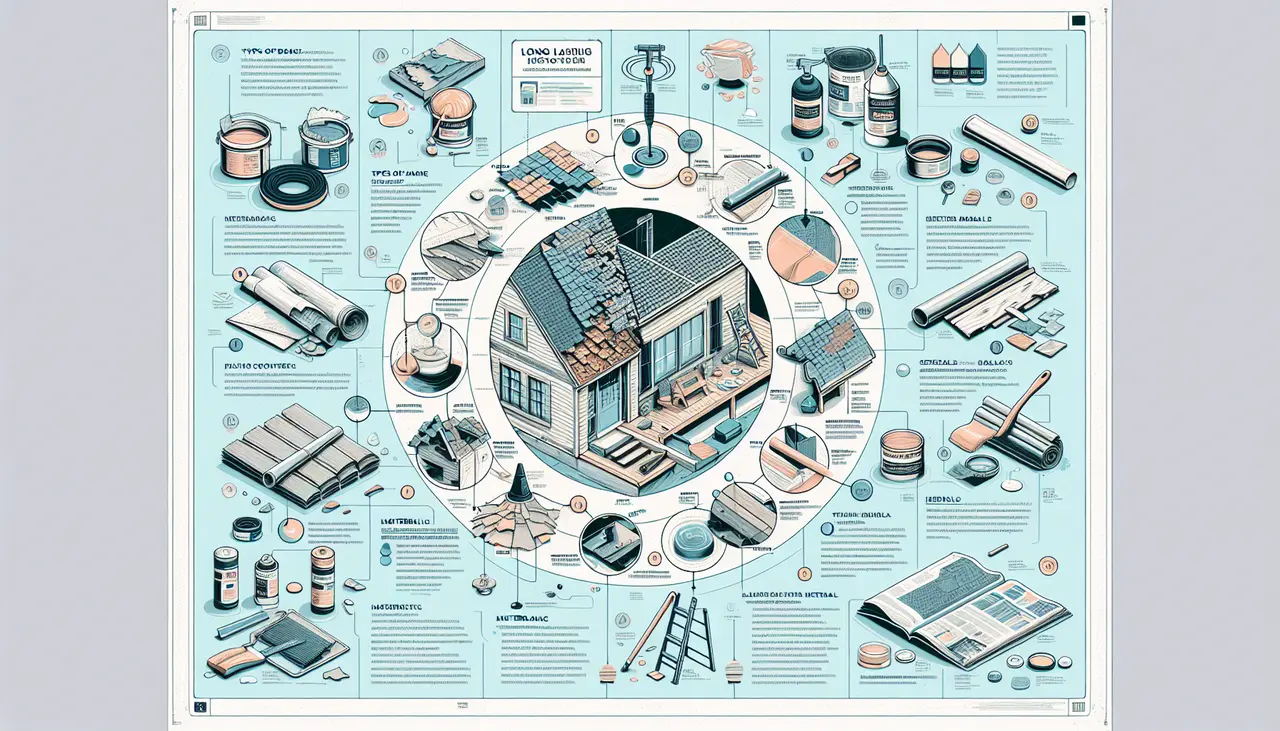Introduction to Roof Leak Repair: Importance and Impact
Roof leaks are a nightmare no homeowner wants to face. They’re more than just a hassle; they’re a sign your home’s first line of defense is failing. Ignoring a leak can lead to serious problems like mold, structural damage, and even ruined insulation. That small drip might not seem like much now, but it can turn into a flood of issues if not fixed promptly. The importance of tackling roof leak repairs can’t be overstated. Fixing leaks quickly prevents minor problems from becoming big, expensive ones. It’s also about your home’s health; dampness can lead to health issues for those living in the house. Understanding the impact of roof leaks is the first step in addressing them effectively. It’s not just about the immediate fix but ensuring the repair lasts. Choosing the right materials and addressing leaks swiftly ensures your home stays dry, safe, and sound.
Understanding Roof Material Options for Leak Repairs
When fixing a leaky roof, the choice of materials matters a lot. Think simple but effective. First off, you’ve got shingles, which come mainly in asphalt, wood, metal, and slate. Asphalt shingles are the go-to for most because they’re affordable and easy to find. If you want something that looks a bit fancier and can take more of a beating from the weather, metal or slate might be your alley, though they’ll hit your wallet harder. Wood shingles look great but think about your area’s fire codes—safety first. Now, for the actual leak repair, you might need to patch things up with roofing cement or a waterproof membrane, especially around chimneys or vent pipes where leaks love to start. It’s not just about slapping something on and calling it a day. You need to think about your roof’s age, the local climate, and yes, your budget. Go for materials that offer a good balance between longevity and cost. Don’t cheap out, or you’ll be doing this all over again sooner than you’d like. Remember, the right material choice now means a sturdy, leak-free roof over your head for years to come.
Evaluating Durability: What Makes Materials Last Longer?
When picking materials for roof leak repairs, think durability first. Durability means how long something can last under tough love from Mother Nature. Some materials tough it out longer than others. Metal roofs, for instance, can last up to 50 years or more. They laugh in the face of harsh weather. Next up, tiles – either clay or concrete – can also see up to 50 years on the clock. They’re like the strong, silent type, heavy and sturdy. Then there’s asphalt shingles, the popular choice. They’re more like the friend who might bail early from the party; they typically stick around for 15 to 30 years. Choosing the right material isn’t just about picking the toughest kid on the block. You’ve also got to consider how well it plays with your house’s structure and if it’s the right fit for your local climate. Metal roofs? Great for shedding snow. Tiles? They’ve got your back in hot, sunny climates. And asphalt shingles? They’re pretty versatile but might need a little more TLC in extreme weather. So, durability isn’t just about a long lifespan. It’s about strength, adaptability, and a bit of matchmaking between your home and the heavens above.
Cost Considerations in Choosing Roof Repair Materials
When you’re fixing a roof leak, think about the money. Not all materials are the same, and prices can swing wide. Asphalt shingles, for instance, are wallet-friendly, going for about (90 to )100 per square (a square covers 100 square feet). On the high end, metal roofing can pitch you back (500 to )1,800 per square. Then there’s tile and slate, which can climb to a steep (600 to )4,000 per square. But cheaper isn’t always better. Asphalt might save you now, but metal roofs laugh at the weather for 50 years or more. Tiles and slate? They could stand guard over your home for a century. So, when you’re crunching numbers, weigh how long you plan to stay beneath your roof against the upfront cost. It’s not just a repair; it’s an investment. And remember, a good chunk of what you pay is for labor, so picking a durable material might mean fewer repairs down the line, saving cash in the long run.
Performance in Extreme Weather: What Works Best?
When picking roofing materials for repairs, think about how they’ll hold up in extreme weather. Not all materials are created equal. Asphalt shingles are popular because they’re affordable and easy to install. Yet, they may not be the best in areas with fierce winds or heavy snow. Metal roofing, on the other hand, excels in resisting wind, is great at shedding snow and ice, and can handle hot sun without issues. It costs more upfront but pays off with its durability. Tile roofing offers a premium look and excellent resistance to heat and hurricanes, but it’s heavy and requires a strong roof structure. In areas with lots of rain or snow, consider materials like rubber or specially treated wood shakes that resist water and rot. Always weigh the cost against how long the material will last in your specific climate. Remember, going cheap might cost more in the long run if you have to repair or replace the roof again soon.
Eco-Friendly and Sustainable Roofing Solutions
Going green isn’t just for your groceries or car; it’s also for your roof. Choosing eco-friendly materials for your roof repairs can have a bit impact not just on your carbon footprint but also on the long-term health of our planet. Luckily, there are several sustainable options out there. Metal roofing is a top pick. It’s durable, reflects sunlight, and is 100% recyclable at the end of its life. Then there’s green roofing, literally a garden on your roof, which can improve insulation and promote biodiversity. Slate and clay tiles are also great; they’re natural, long-lasting, and help in keeping your house cool. Recycled shingles, made from waste materials like plastic, rubber, or wood fiber, offer an eco-conscious choice without compromising on durability. Lastly, solar tiles might be on the pricier side, but they’ll save you money on energy in the long run. By picking any of these materials, you’re not just fixing your roof; you’re contributing to a healthier planet.
Weight and Structural Considerations for Roof Repairs
When repairing a roof leak, choosing the right materials isn’t just about stopping water; it’s also about not overburdening your house. Different materials have different weights, and your home’s structure can only support so much. Asphalt shingles are light and work well on most homes. Metal roofing, while still not too heavy, adds a bit more weight but brings durability. On the heavier end, slate and tile offer longevity but require a sturdier frame. Before picking, assess your home’s capacity to handle the load. Going too heavy without proper support can lead to disaster, while going too light might mean more repairs down the line. Get the balance right, and you secure both your home and peace of mind.
Compatibility with Existing Roof Materials
Choosing materials that match your current roof is crucial for leak repairs that last. Imagine using materials that don’t fit well with what you already have. It’s like wearing a raincoat over a swimsuit to a formal event. Doesn’t make sense, right? Your roof feels the same way. If your home sports asphalt shingles, stick with those for repairs. Mixing materials, like throwing in some metal pieces on an asphalt roof, invites more trouble than it fixes. It’s not just about looks. Different materials expand, contract, and react to weather changes in their way. If you pair materials that don’t get along, you’re setting up a future meeting with leaks again. So, keep it simple and compatible. It’s the smart move for a healthy roof.
Professional Installation vs. DIY: Impact on Longevity
When it comes down to roof leak repairs, the way the repair is done can greatly impact how long your fix will last. Going with a professional to handle your roof repairs often means better longevity. Experts know the ins and outs. They’ve seen it all and have the skills and tools to tackle the problem correctly. This expertise means they can spot issues that you might miss and ensure the repair integrates seamlessly with your existing roof, helping it last longer. On the flip side, opting for a DIY approach can be tempting, especially to save some cash. However, without the proper knowledge and tools, it’s easy to miss crucial details or use materials improperly. This could lead to more frequent repairs in the future, costing you more in the long run. Plus, a botched DIY job can sometimes void warranties or insurance claims. Ultimately, while DIY might seem cheaper and more immediate, a professional installation can offer better peace of mind and a more durable, long-lasting solution.
Summary: Making the Best Decision for Your Roof Leak Repair
Fixing a leaky roof isn’t just about stopping the drip. It’s about choosing the right materials to make sure you won’t be climbing back up there anytime soon. Here’s the thing—different roofs need different fixes. For instance, metal roofs might do best with sealants that are tough against the elements, while traditional shingle roofs could benefit more from asphalt-based products. Price plays a part too. High-quality materials might cost more upfront, but they’re an investment in your roof’s future. Think about the climate you live in. Areas with heavy rainfall or snowfall need materials that can stand up to water and cold without cracking under pressure. Your decision impacts how long the repair will hold, so consider durability, cost, and the weather. It’s not just a repair; it’s protecting your home. Choosing wisely means you spend less time worrying about the next leak and more time dry and comfortable.







